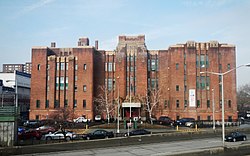
Riverside Park is a scenic waterfront public park in the Upper West Side, Morningside Heights, and Hamilton Heights neighborhoods of the borough of Manhattan in New York City. The park measures 4 miles (6.4 km) long and 100 to 500 feet wide, running between the Hudson River and Henry Hudson Parkway to the west and the serpentine Riverside Drive to the east.

Morningside Heights is a neighborhood on the West Side of Upper Manhattan in New York City. It is bounded by Morningside Drive to the east, 125th Street to the north, 110th Street to the south, and Riverside Drive to the west. Morningside Heights borders Central Harlem and Morningside Park to the east, Manhattanville to the north, the Manhattan Valley section of the Upper West Side to the south, and Riverside Park to the west. Broadway is the neighborhood's main thoroughfare, running north–south.

Fifth Avenue is a major and prominent thoroughfare in the borough of Manhattan in New York City, New York, United States. It stretches north from Washington Square Park in Greenwich Village to West 143rd Street in Harlem. It is one of the most expensive shopping streets in the world.

The 369th Infantry Regiment, originally formed as the 15th New York National Guard Regiment before being re-organized as the 369th upon federalization and commonly referred to as the Harlem Hellfighters, was an infantry regiment of the New York Army National Guard during World War I and World War II. The regiment consisted mainly of African Americans, though it also included men from Puerto Rico, Cuba, Guyana, Liberia, Portugal, Canada, the West Indies, as well as American white officers. With the 370th Infantry Regiment, it was known for being one of the first African-American regiments to serve with the American Expeditionary Forces during World War I.
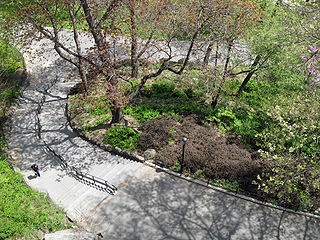
Morningside Park is a 30-acre (12-hectare) public park in Upper Manhattan, New York City. The park is bounded by 110th Street to the south, 123rd Street to the north, Morningside Avenue to the east, and Morningside Drive to the west. A cliff made of Manhattan schist runs through the park and separates Morningside Heights, above the cliff to the west, from Harlem. The park includes other rock outcroppings; a human-made ornamental pond and waterfall; three sculptures; several athletic fields; playgrounds; and an arboretum. Morningside Park is operated by the New York City Department of Parks and Recreation, although the group Friends of Morningside Park helps maintain it.

Harlem River Drive is a 4.20-mile (6.76 km) controlled-access parkway in the New York City borough of Manhattan. It runs along the west bank of the Harlem River from the Triborough Bridge in East Harlem to 10th Avenue in Inwood, where the parkway ends and the road continues northwest as Dyckman Street. South of the Triborough Bridge, the parkway continues toward lower Manhattan as FDR Drive. All of Harlem River Drive is designated New York State Route 907P (NY 907P), an unsigned reference route.

The University Heights Bridge is a steel-truss revolving swing bridge across the Harlem River in New York City. It connects West 207th Street in the Inwood neighborhood of Manhattan with West Fordham Road in the University Heights neighborhood of the Bronx. The bridge is operated and maintained by the New York City Department of Transportation.
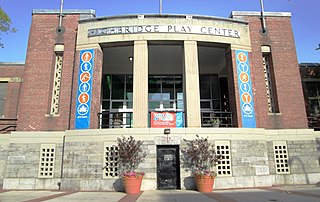
Highbridge Park is a public park on the western bank of the Harlem River in Washington Heights, Manhattan, New York City. It stretches between 155th Street and Dyckman Street in Upper Manhattan. The park is operated by the New York City Department of Parks and Recreation. The City maintains the southern half of the park, while the northern half is maintained by the non-profit New York Restoration Project. Prominent in the park are the Manhattan end of the High Bridge, the High Bridge Water Tower, and the Highbridge Play Center.
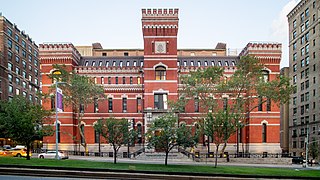
The Park Avenue Armory, also known as the 7th Regiment Armory, is a historic National Guard armory building at 643 Park Avenue in the Upper East Side neighborhood of Manhattan in New York City. Designed in the Gothic Revival style by Charles Clinton for the 7th New York Militia Regiment, the Park Avenue Armory was completed in 1880, with two expansions in the early 20th century. The building and its interior are New York City designated landmarks, and the structure was made a National Historic Landmark in 1986. Since 2006, it has been the home of the Park Avenue Armory Conservancy, which leased the building for 99 years from the New York state government. The 53rd Digital Liaison Detachment of the New York Army National Guard, the Veterans of the 7th Regiment, and the Lenox Hill Neighborhood House also occupy parts of the armory.

The 69th Regiment Armory is a historic National Guard armory building located at 68 Lexington Avenue between East 25th and 26th Streets in the Rose Hill section of Manhattan in New York City. Completed in 1906, the armory was designed by the firm of Hunt & Hunt in the Beaux-Arts style. The building is a New York City designated landmark and is listed on the National Register of Historic Places as a National Historic Landmark.

Crotona Park is a public park in the South Bronx in New York City, covering 127.5 acres (51.6 ha). The park is bounded by streets of the same name on its northern, eastern, southern, and western borders, and is adjacent to the Crotona Park East and Morrisania neighborhoods of the Bronx. It is divided into four portions by Claremont Parkway and Crotona Avenue, which run through it.
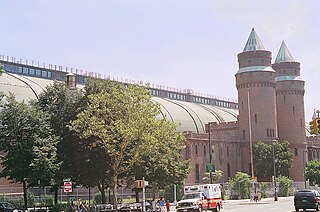
The Kingsbridge Armory, also known as the Eighth Regiment Armory, is a decommissioned armory at Jerome Avenue and West Kingsbridge Road in the Kingsbridge Heights neighborhood of the Bronx in New York City. It was built in the 1910s, from a design by the firm of then-state architect Lewis Pilcher to house the New York National Guard's Eighth Coast Defense Command, a regiment-sized unit which relocated from Manhattan in 1917. It is possibly the largest armory in the world.
The Park Avenue Armory Conservancy is a nonprofit cultural institution housed within the historic Park Avenue Armory building located at 643 Park Avenue on New York City's Upper East Side. The institution displays unconventional artwork, including performing and visual arts.
Tachau and Vought was an American architectural firm active in the mid-twentieth-century New York City that specialized in mental hygiene hospitals. It was established in 1919 as the successor to the architectural firm of Pilcher and Tachau by William G. Tachau and Vought. By 1946, Vought had left. Eliot Butler Willauer was a principal from around 1945 until 1946. The firm moved from 109 Lexington Avenue to 102 East 30th Street around 1923.

The 23rd Regiment Armory, also known as the Bedford Atlantic Armory, is a historic National Guard armory building located at 1322 Bedford Avenue between Atlantic Avenue and Pacific Street in the Crown Heights neighborhood of Brooklyn, New York City, United States. The building is a brick and stone castle-like structure designed to be reminiscent of medieval military structures in Europe. It was built in 1891–95 and was designed in the Romanesque Revival style by Fowler & Hough, local Brooklyn architects, and Isaac Perry, the New York state government's architect.

The 14th Regiment Armory, also known as the Eighth Avenue Armory and the Park Slope Armory, is a historic National Guard armory building located on Eighth Avenue between 14th and 15th Streets in the South Slope neighborhood of Brooklyn, New York City, United States. The building is a brick and stone castle-like structure, and designed to be reminiscent of medieval military structures in Europe. It was built in 1891–95 and was designed in the Late Victorian style by William A. Mundell.

Jackie Robinson Park is a public park in the Hamilton Heights and Harlem neighborhoods of Manhattan in New York City. The approximately 12.77-acre (5.17 ha) park is bounded by Bradhurst Avenue to the east, 155th Street to the north, Edgecombe Avenue to the west, and 145th Street to the south. The park has baseball fields, basketball courts, restrooms, and a bandshell, which are arranged around the park's steep terrain. It also includes the Jackie Robinson Play Center, which consists of a recreation center and a pool. Jackie Robinson Park is maintained by the New York City Department of Parks and Recreation.

Grand Central Terminal is a major commuter rail terminal in Midtown Manhattan, New York City, serving the Metro-North Railroad's Harlem, Hudson and New Haven Lines. It is the most recent of three functionally similar buildings on the same site. The current structure was built by and named for the New York Central & Hudson River Railroad, though it also served the New York, New Haven and Hartford Railroad. Passenger service has continued under the successors of the New York Central and New Haven railroads.

The 13th Regiment Armory is a historic armory designed by architects Rudolph L. Daus and Fay Kellogg and built in 1892–1894. It is located at 357 Marcus Garvey Boulevard between Putnam and Jefferson Avenues in Bedford-Stuyvesant, Brooklyn, New York City. Daus had previously designed the Lincoln Club on Putnam Avenue in 1889.
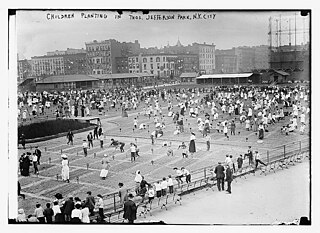
Thomas Jefferson Park is a 15.52-acre (6.28 ha) public park in the East Harlem neighborhood of Manhattan in New York City. The park is on First Avenue between 111th and 114th Streets. It contains a playground as well as facilities for baseball, basketball, football, handball, running, skating, and soccer. The Thomas Jefferson Play Center within the park consists of a recreation center and a pool. The park and play center, named for former U.S. president Thomas Jefferson, are maintained by the New York City Department of Parks and Recreation.
